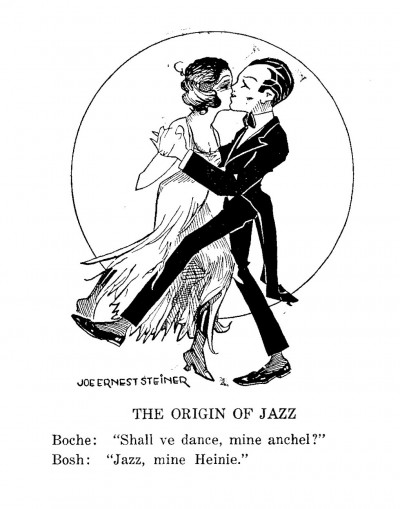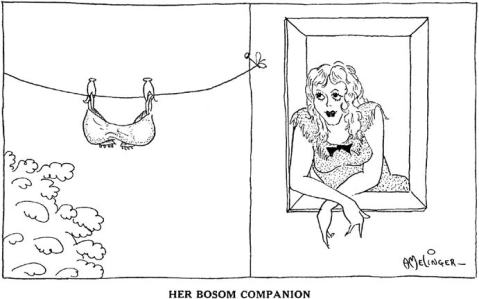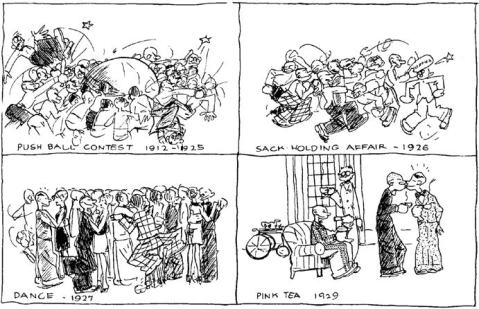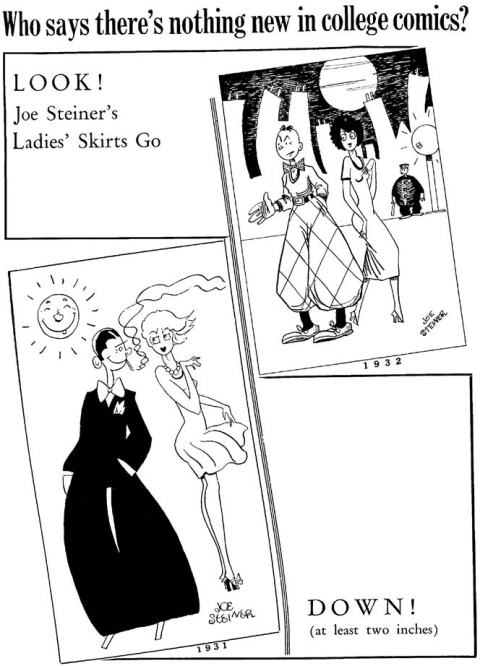Comic Relief
August 26, 2016 § 2 Comments
The golden age of cartooning in Austin began with the Jazz Age. And since the jazz life was all about fun, UT jazzers got their own humor magazine in October 1919: the Scalper, a slick paper monthly. Since the death of the Coyote for insolence several years earlier, there had been no campus comic publication. The Scalper aimed to be like the Harvard Lampoon. Jack Hyman was the debut editor but was kicked out of school less than a month on the job. The Scalper would be in hot water with the UT administration throughout its short life.
During its first year, each issue of the Scalper lampooned one of the burning issues of the day, including Bolshevism, the Ku Klux Klan, Prohibition, free love, jazz and intellectualism.
The Scalper featured the artwork of a good half dozen of Austin’s all-time greatest cartoonists, including Roy Crane, Ralph Jester and Joe Ernest Steiner.
Roy Crane, Ralph Jester and Joe Ernest Steiner were UT freshmen in the fall of 1919 and began cartooning for the Scalper and Cactus yearbook. Creator of Captain Easy, Crane was the father of adventure story cartoon strips. Some of Austin’s foremost music poster artists cited Crane as a primary influence 50 years later.

Joe Ernest Steiner was the younger brother of Austin’s legendary T.C. “Buck” Steiner, world rodeo champion, “bubble dancer” Sally Rand’s boyfriend and founder of Austin’s Capital Saddlery. Joe Ernest went on to become the most prolific cartoonist for college and mainstream humor magazines during the Jazz Age, before settling down as a lawyer in Austin.
Ralph Jester moved on to create covers for the New Yorker before moving to Hollywood for  a career in movie set design.
a career in movie set design.
“Vulgar cheek dancing” got the administration’s long johns in such a knot that toward

Origin of Jazz, March 1920
the middle of the evening of November 18, dean of women Miss Lucy Newton interrupted to give a short talk on modern dancing and its application in university activities, followed by floor manager G.F. Simmons, who said that “death grabs” and other objectionable forms of dancing were to be prohibited.
The UT administration was not just cracking down on objectionable forms of dancing, as the Scalper’s editors observed in November 1921: “The University of Texas’ system of morality is based, it seems to us, on this sterling principle: that if a boy and a girl are alone for as much as one minute they will instantly commit a loathsome indiscretion.” Such editorializing did not win the Scalper many friends in the administration.

“Free Love” Cover of Scalper, the UT Student Humor Magazine March 1922
The Scalper was fighting for its life during April 1922, following the publication of its “Free Love” issue. In May, the Scalper staff resigned.
Following a series of controversial issues, the administration tomahawked the Scalper after the November 1922 issue, and UT was left without a comic magazine.

In the spring of 1923, acknowledging the student body’s need for a campus comic magazine, the Publications Board authorized the publication of a new comic magazine: the Texas Ranger.
When the Texas Ranger debuted in October 1923, it was an immediate success.
It immediately attained a circulation of 4,500 copies and exchanged jokes and cartoons with the country’s leading university and college comic magazines.
Despite promises of modesty, the Ranger’s jokes, humorous pieces and artwork were as risqué as anything seen in the Scalper, if not more so.
 The March 1927 issue of the Ranger, dedicated to campus beauties, featured a cover drawn by John Canaday. Canaday was one of the Ranger’s raciest cartoonists; his style was distinct from that of Joe Steiner, sexy in a sophisticated, artful, continental way, as opposed to Steiner’s outlandish, more cartoony, Sheba/sheik style—which was not surprising, since John was a French and English literature major. Canaday’s girls were not afraid to show off their erect nipples, tight asses and shapely legs, clad in garter belts, bathing suits, clingy transparent dresses and even lesser forms of provocative dress.
The March 1927 issue of the Ranger, dedicated to campus beauties, featured a cover drawn by John Canaday. Canaday was one of the Ranger’s raciest cartoonists; his style was distinct from that of Joe Steiner, sexy in a sophisticated, artful, continental way, as opposed to Steiner’s outlandish, more cartoony, Sheba/sheik style—which was not surprising, since John was a French and English literature major. Canaday’s girls were not afraid to show off their erect nipples, tight asses and shapely legs, clad in garter belts, bathing suits, clingy transparent dresses and even lesser forms of provocative dress.
The Texas Ranger bit the dust in May 1929, banned like the Coyote and Scalper before it, a victim of its own cleverness. It reemerged—emasculated—that fall, combined with the Texas Longhorn, the university’s literary magazine, as the Longhorn-Ranger Magazine. It was a harbinger of things to come.
A Gallery of Scalper and Cactus Cartoons













XEKE,
this is excellent. and it comes at a time when I am searching for something and can’t seem to locate it. Remember that Sidney Porter made some hilarious remarks about violence & bawdiness on Sixth Street, and included a line something like “The First [?] Ward will have to bust its bloody stumps to beat ….” Sound familiar? I think he was writing in the Houston paper at that time.
Hope this finds you doing well.
Jesse
>
That quote came from the April 13, 1894 issue of The Rolling Stone and is included in Guy Town by Gaslight.
“It behooves the bloody first ward to stir its stumps if it wishes to keep the belt for being a tough locality. East Pecan and the vicinity, once the center of business, where the mild-eyed granger traded eggs and butter for the delusive calico, and drank his red lemonade in peace, has now risen up and declared itself bold, bad and hard to curry. Loafing, gambling, fighting and drinking have invaded this Arcadian spot. Let us pass some more laws against this kind of thing and then let it go on as usual.”
He also wrote about the cocaine problem along West 6th on another occasion.